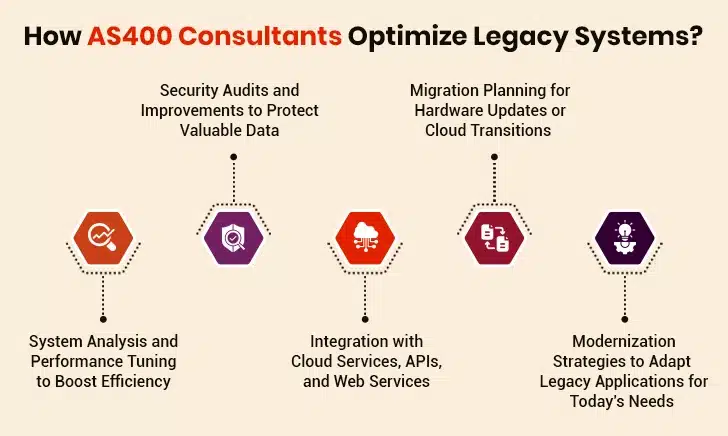As technology advances, businesses face the challenge of updating old AS400 systems to compete in today’s world, which values flexibility and agility. These challenges also present opportunities for tackling the issues that plague their aging infrastructure. This can be achieved through AS400 consulting.
AS400 consultation helps streamline workflows and enhance operational efficiency. It also assists with the integration of modern technologies, reducing maintenance overheads and mitigating security risks. Together, these steps enable businesses to revive legacy AS400 systems.
AS400 consultation allows businesses to overcome the challenges of legacy systems by revitalizing, rejuvenating, and reinventing outdated infrastructure in an evolving landscape. Today, harnessing the expertise of AS400 managed services providers is not just a choice, but a strategic imperative that helps organizations get more value from their legacy systems and ensure reliable, ongoing operations.
This piece explores how businesses can tackle legacy system challenges through mutually beneficial AS400 partnerships. It also covers key factors one should consider when choosing a consulting partner and practical steps to begin a modernization journey.
Table of Contents
Tackling the Challenges of Legacy Systems with AS400 Consultation
Choosing the Right AS400 Consulting Partner: Key Considerations
The Path Forward: Getting Started with iSeries Consulting
Tackling the Challenges of Legacy Systems with AS400 Consultation
1. Vendor Lock-in
“For many organizations, legacy systems are seen as holding back the business initiatives and business processes that rely on them. When a tipping point is reached, application leaders must look to application modernization to help remove the obstacles.”
-Stefan Van Der Zijden, VP Analyst, Gartner
Vendor lock-in is a significant challenge that plagues AS400 legacy systems. Their proprietary nature and dependence on IBM technologies, makes it challenging for organizations to switch to alternative vendors or platforms. Breaking free from vendor lock-in requires consultation from experts to diversify technology investments, adopt open standards, and gradually make a transition to more flexible and interoperable platforms.
By seeking end-to-end consultation from experts, organizations can develop a strategic roadmap for diversifying technology investments and reducing dependence on proprietary solutions. This may involve migrating applications or workloads from legacy systems to more flexible and interoperable platforms such as Linux or Windows. Consultants may also encourage adopting open-source software and standards-based technologies to promote vendor neutrality.
In short, harnessing the expertise of AS400 consultants allows organizations to mitigate the risks of vendor lock-in. It also helps them optimize their technology stack for long-term success and discover new opportunities for growth and innovation.
How Neglecting AS400 Modernization Will Impact Business Operations
2. Integration Issues
AS400 legacy systems face integration challenges due to their proprietary nature and outdated technology. These systems struggle to connect seamlessly with modern applications, platforms, and external systems. Addressing this challenge requires meticulous planning, customized integration solutions, and end-to-end consultation from AS400 consultants.
Their expertise bridges the wide gap between legacy systems and modern environments. This enables organizations to stay competitive in the interconnected business landscape while getting the most value from their technology investments.
These consultants conduct an exhaustive assessment of the existing infrastructure to identify compatibility issues, data flow, and integration points. Based on this assessment, they craft and implement integration strategies. These strategies leverage service-oriented architectures, APIs, or middleware to bridge the gap between legacy and external systems. These experts also advise on the adoption of microservices architectures for decoupling monolithic AS400 applications. This facilitates better interoperability with third-party applications and platforms.
3. Lack of Flexibility
AS400 systems are known for their reliability and stability. However, the lack of flexibility inherent in these legacy systems poses a significant obstacle for organizations that aim to adapt to modern technological advancements and changing business dynamics.
Solving this challenge requires strategic planning and consultation. It also demands investment in modernization efforts, such as adopting modular architectures, implementing microservices architectures, and integrating cloud solutions to unlock the full potential of these legacy systems.
AS400 consultants help break down monolithic systems into smaller, more manageable components using modular architecture. They can also implement microservices to break down complex functionalities into independent, deployable services.
This approach fosters innovation and agility. It enables organizations to introduce new features or enhancements to respond quickly to evolving market demands whilst staying competitive in a rapidly evolving business environment. Lastly, AS400 consultants may also propose migrating legacy systems to cloud environments, providing the much-needed flexibility to dynamically scale resources based on demand.
The Ultimate Guide to Migrating AS400/IBM i Applications to the Cloud
4. Security Risks
Security risks in AS400 legacy systems stem from a range of factors. These include lack of regular security updates, vulnerabilities inherent in outdated technology, and limited support for modern security protocols.
Addressing security risks requires end-to-end consultation from AS400 experts. These specialists conduct comprehensive security assessments and implement robust security measures, including regular security audits, encryption, multi-factor authentication, access controls, and intrusion detection systems to prevent unauthorized access or breaches.
Consultants typically begin security assessments by conducting a detailed evaluation of the AS400 environment. They identify potential vulnerabilities, assess cyber threats, and evaluate existing security measures. Based on this assessment, they craft a tailored security strategy entailing multiple layers of protection, including encryption, network security, and intrusion detection systems. They may also recommend implementing role-based access controls, multi-factor authentication, and least privilege principles to restrict access to sensitive data and critical system resources.
AS400 consultants also provide proactive monitoring and IBM i managed services to identify and mitigate security incidents in real-time.This minimizes potential damage and ensures round-the-clock business continuity.
Choosing the Right AS400 Consulting Partner: Key Considerations
Picking the right consulting partner for AS400 systems goes well beyond checking basic service requirements. Smart partners bring specific qualities that directly affect your project outcomes and return on investment.
I. Extensive Consulting Experience
Businesses should look for consultants who have worked extensively with IBM iSeries environments. Good partners know the ins and outs of hardware, software, and security in AS400 systems. Their team excels in IBM i, RPG programming, and DB2 databases. Companies with over two decades of platform experience usually provide better value than generalists who have limited knowledge of AS400.
II. Proven Delivery Track Record
A reliable partner would demonstrate their successful project completions that match your needs. It is recommended to ask for case studies and client references to verify what they can do. Leading firms keep clear project dashboards that show performance metrics and milestone achievements. These tools help clients track progress easily.
III. Clear Methodology
Expert consultants work with proven methodologies. They start with a complete picture of your setup to understand business goals, spot gaps, and find opportunities. Based on this evaluation, they create clear roadmaps that line up with your business objectives.
IV. Focus on Partnership
Technical skills matter, but consultants should care about the success of your AS400 project. The consultant-client relationship works best when it’s built on trust and honesty. Good partners work closely with your team to create the best business solutions instead of forcing standard approaches.
V. Communication and Transparency
Reliable AS400 partners keep communication channels open. They use project dashboards and status reports to update all stakeholders regularly. This openness helps address issues quickly and keeps projects in sync with business goals. It is, therefore, important to ask potential partners about their communication practices and reporting methods to see if they match your organization’s needs.
The Path Forward: Getting Started with iSeries Consulting
A structured approach helps maximize returns when you start your iSeries AS400 consulting journey. Organizations must complete several vital preparatory steps before reaching out to potential partners.
1. Internal Assessment: Document Key Pain Points, Goals, and Constraints
The first step should be a detailed analysis of your current AS400 environment. Document your specific business challenges, operational bottlenecks, and technical limitations. Additionally, identify aging RPG/COBOL programmers near retirement and skill gaps in your team. List both immediate concerns and long-term objectives, then rank them based on how they affect business. This assessment will become the foundation for all your future decisions.
2. Define Scope: Identify a Specific, High-Impact Area to Start
The best approach is to select a focused starting point instead of trying a complete system overhaul. Security audits, UI modernization for specific applications, or integration projects that connect AS400 with newer technologies are some areas to begin with. This targeted strategy delivers measurable results within a short time frame. It also reduces risk and operational disruption.
3. Research Partners: Shortlist Consultants Based on Multiple Criteria
After defining your scope, review potential partners using the criteria mentioned earlier. Check their technical expertise in IBM i environments and relevant experience with projects similar to yours. Make sure to ask for case studies that demonstrate successful implementation in your industry.
4. Engage For Discovery: Initiate Discussions, Request Proposals
Schedule initial consultations with the shortlisted consultants. Reputable consultants will create detailed assessments to understand your business goals, current setup, and opportunities during these meetings. At this stage, it is advisable to ask for detailed proposals that outline a consultant’s approach, timeline, and cost structure.
5. Develop a Roadmap: Partner with Consultants to Create a Phased Plan
The final step is to cooperate with your chosen partner to create a strategic implementation plan. Effective roadmaps include high-level objectives, detailed milestones, resource allocation, risk mitigation strategies, and data migration considerations. This phased approach puts priorities in the right order based on their business impact and technical dependencies.
Red Flags and Mistakes to Avoid When Choosing a Partner
Selecting the wrong consulting partner can derail your modernization efforts and drain your resources. It is essential to spot warning signs early to avoid getting burned with your technology investments.
I. Generic Solutions with No Industry Focus
A major red flag shows up when consultants offer one-size-fits-all approaches without knowing your industry’s needs. Many consulting companies jump into AS400 automation and modernization projects without proper planning, which leads to poor results. Consultants who suggest generic solutions to fix broad problems instead of your specific challenges don’t deliver satisfactory results. That is why it is recommended to choose partners who know your industry’s unique processes well. They must, for example, understand the production workflows of manufacturers or the compliance requirements of financial institutions.
II. Lack of Post-Project Support
Post-implementation support is vital since companies spend a large portion of their software project budgets fixing errors after implementation. Consulting companies often rush to apply quick fixes that do not eliminate the problem completely and create more issues down the line. Quality AS400 consultants provide well-laid-out ongoing support options. They assist with updates, patching, and maintenance long after the project has ended.
III. No Clear Methodology or Case Studies
Partners without proven methods or success stories should raise eyebrows. Reliable consultants have project templates, data conversion tools, and user training docs from their past experiences. It is important to watch out for firms that keep switching team members throughout your project, as this wastes time and money. One should seek consultants who run weekly status meetings with tracked action items, clear milestones, and solid accountability systems.
The Final Word
Navigating the complexities associated with AS400 legacy systems requires a strategic approach that combines deep technical expertise with a comprehensive understanding of business objectives. AS400 consulting offers support in this transformative journey offering through tailored solutions that allow businesses to overcome the challenges associated with legacy systems.
From mitigating vendor lock-in to enhancing security measures, AS400 consultants provide foolproof insights and guidance every step of the way. They implement strategic modernization without disrupting business operations. Their fresh perspective breaks through organizational limits while bringing industry best practices that turn aging systems into modern business assets.
Picking the right consulting partner, however, requires careful evaluation of their track record, technical expertise, methods, teamwork, and how well they communicate. Companies should look past generic credentials. They should ask for specific case studies that show successful results in similar industries and technical environments.
All in all, AS400 consulting offers a practical way forward. Legacy challenges might look tough, but experienced consultants help businesses direct this complex path. They make sure IBM i systems keep delivering value far into the future. Companies that take this approach protect their long-term technology investments while gaining flexibility for ongoing digital transformation.
Case in Focus
A leading Texas-based healthcare company offering advanced medical devices and skincare products. The client was using an AS400-powered electronic patient record system that not only delivered a suboptimal user experience due to the green screen-based interface but also posed challenges in training sales agents. The client recognized the need for modernizing the existing electronic patient records system with a robust GUI while retaining its functionalities and business logic. Damco Solutions partnered with the client to comprehend their business requirements and accordingly developed and deployed a platform-independent, turnkey solution. Dive into this complete case study to find out how Damco helped the client improve ROI and drive significant cost savings.







